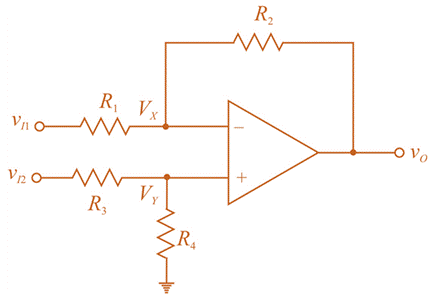
The op−amp in the difference amplifier configuration in Figure P14.60 isideal. (a) If the tolerance of each resistor is ± 1.5%, determine the minimum value of

Figure P14.60
a.
Minimum value of
Answer to Problem 14.60P
Explanation of Solution
Given:
The given difference amplifier circuit is shown below.

Tolerance of each resistor is
Calculation:
Circuit with voltage and resistance notation is,

KCL at
As op-amp is ideal, so
KCL at
Now put
Now,
If
For
For
Now,
For minimum CMRR maximize the denominator i.e.
and
Therefore,
So, minimum value of
b.
Minimum value of
Answer to Problem 14.60P
Explanation of Solution
Given:
The given difference amplifier circuit is shown below.

Tolerance of each resistor is
Calculation:
For tolerance of resistor
As,
For minimum CMRR maximize the denominator that is,
and
Putting the value in equation (3),
So, minimum value of
Want to see more full solutions like this?
Chapter 14 Solutions
MICROELECT. CIRCUIT ANALYSIS&DESIGN (LL)
- What is the input impedance of Common Emitter Collector Feedback preamplifier whose Collector Resistor is 2.7kΩ, Feedback Resistor 180kΩ, Beta=200, Vcc=9V?arrow_forwardDiscuss the difference between the Current series negative feddback amplifier and voltage shunt feedback amplifier.arrow_forwardCollector-feedback configuration 1.Draw the DC equivalent circuit.2.Draw the fixed bias base emitter circuit. Derive IB.3.Draw fixed bias collector emitter loop. Derive VCE.arrow_forward
- Derive a mathematical expression to determine S(VBE) the stability factor for voltage – feedback bias circuitarrow_forwardPREAMPLIFIERS AND AMPLIFIERS What parameters can be varied if one wants to increase the gain of the pre-amplifier circuit?arrow_forwardDiscuss the merits and demrits of feedback.arrow_forward
 Introductory Circuit Analysis (13th Edition)Electrical EngineeringISBN:9780133923605Author:Robert L. BoylestadPublisher:PEARSON
Introductory Circuit Analysis (13th Edition)Electrical EngineeringISBN:9780133923605Author:Robert L. BoylestadPublisher:PEARSON Delmar's Standard Textbook Of ElectricityElectrical EngineeringISBN:9781337900348Author:Stephen L. HermanPublisher:Cengage Learning
Delmar's Standard Textbook Of ElectricityElectrical EngineeringISBN:9781337900348Author:Stephen L. HermanPublisher:Cengage Learning Programmable Logic ControllersElectrical EngineeringISBN:9780073373843Author:Frank D. PetruzellaPublisher:McGraw-Hill Education
Programmable Logic ControllersElectrical EngineeringISBN:9780073373843Author:Frank D. PetruzellaPublisher:McGraw-Hill Education Fundamentals of Electric CircuitsElectrical EngineeringISBN:9780078028229Author:Charles K Alexander, Matthew SadikuPublisher:McGraw-Hill Education
Fundamentals of Electric CircuitsElectrical EngineeringISBN:9780078028229Author:Charles K Alexander, Matthew SadikuPublisher:McGraw-Hill Education Electric Circuits. (11th Edition)Electrical EngineeringISBN:9780134746968Author:James W. Nilsson, Susan RiedelPublisher:PEARSON
Electric Circuits. (11th Edition)Electrical EngineeringISBN:9780134746968Author:James W. Nilsson, Susan RiedelPublisher:PEARSON Engineering ElectromagneticsElectrical EngineeringISBN:9780078028151Author:Hayt, William H. (william Hart), Jr, BUCK, John A.Publisher:Mcgraw-hill Education,
Engineering ElectromagneticsElectrical EngineeringISBN:9780078028151Author:Hayt, William H. (william Hart), Jr, BUCK, John A.Publisher:Mcgraw-hill Education,





